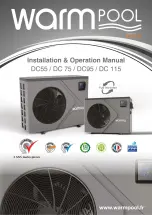
24
UNIT DAMAGE HAZARD
Failure to follow this caution may result in equipment
damage or improper operation.
Never use the system compressor as a vacuum pump.
CAUTION
!
Refrigerant tubes and indoor coil should be evacuated using the
recommended deep vacuum method of 500 microns. The alternate
triple evacuation method may be used if the procedure outlined
below is followed. Always break a vacuum with dry nitrogen.
Final Tubing Check
IMPORTANT: Check to be certain factory tubing on both indoor
and outdoor unit has not shifted during shipment. Ensure tubes are
not rubbing against each other or any sheet metal. Pay close
attention to feeder tubes, making sure wire ties on feeder tubes are
secure and tight.
START−UP
Test Operation
Perform test operation after completing gas leak and electrical
safety check (see Fig. 49).
Infrared receiver
Timer indicator
Alarm indicator
PRE-DEF
(pre-heating/defrost)
indicator
Manual button
Operation indicator
LED display
Fig. 49 −
IR Receiver Display Panel
1. Press MANUAL on the IR receiver located in the control
box to begin testing.
NOTE: A protection feature prevents air conditioner from being
activated for approximately 3 to 4 minutes.
2. Push MODE, select COOLING, HEATING, FAN mode
to check if all functions work correctly.
3. To run the test using the MANUAL button in the indoor
unit:
(3.) Open front panel of the indoor unit;
(4.) Push the manual switch once to energize the unit.
The set conditions of manual operation are as
follows:
· Preset set point: 76
_
F (24
_
C)
· Fan speed: AUTO
· Discharge air direction: Pre−set position based on
operation in “Cool” or “Heat” mode.
4. Be sure to set the manual switch to OFF (by pushing it
twice again) after finishing the test operation.
SYSTEM CHECKS
1. Conceal the tubing where possible.
2. Ensure the drain tube slopes downward along its entire
length.
3. Ensure all tubing and connections are properly insulated.
4. Fasten tubes to the outside wall, when possible.
5. Seal the hole through which the cables and tubing pass.
INDOOR UNIT
1. Do all remote control buttons function properly?
2. Do the display panel lights work properly?
3. Does the air deflection louver function properly?
4. Does the drain work?
Explain Following Items To Customer (with the aid of the
Owner’s Manual):
1. How to turn air conditioner on and off; selecting
COOLING, HEATING and other operating modes;
setting a desired temperature; setting the timer to
automatically start and stop air conditioner operation; and
all other features of the remote control and display panel.
2. How to remove and clean the air filter.
3. How to set air deflection louver.
4. Explain care and maintenance.
5. Present the owner’s manual and installation instructions to
customer.
FAN MOTOR MAINTENANCE
The rear ventilated panel is used as an example.
Motor Maintain:
1. Take off the ventilated panel.
2. Take off the blower housing.
3. Take off the motor.
Motor
Blower housing
Ventilated panel
Fig. 50 −
Maintain the Motor
Summary of Contents for 40MBDQ series
Page 6: ...6 DIMENSIONS CONT Airflow Airflow Fig 5 Indoor Unit Sizes 58K...
Page 14: ...14 FAN PERFORMANCES AT VARYING STATIC PRESSURES CONT Fig 32 Fan Performance 40MBDQ09...
Page 15: ...15 FAN PERFORMANCES AT VARYING STATIC PRESSURES CONT Fig 33 Fan Performance 40MBDQ12...
Page 16: ...16 FAN PERFORMANCES AT VARYING STATIC PRESSURES CONT Fig 34 Fan Performance 40MBDQ18...
Page 17: ...17 FAN PERFORMANCES AT VARYING STATIC PRESSURES CONT Fig 35 Fan Performance 40MBDQ24...
Page 18: ...18 FAN PERFORMANCES AT VARYING STATIC PRESSURES CONT Fig 36 Fan Performance 40MBDQ36...
Page 19: ...19 FAN PERFORMANCES AT VARYING STATIC PRESSURES CONT Fig 37 Fan Performance 40MBDQ48...
Page 20: ...20 FAN PERFORMANCES AT VARYING STATIC PRESSURES CONT Fig 38 Fan Performance 40MBDQ58...



































